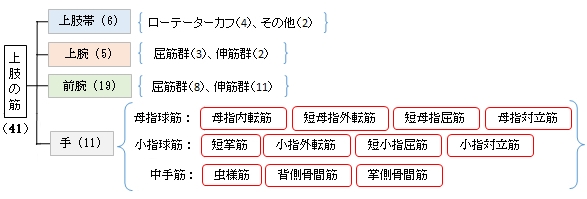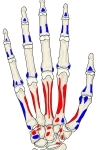掌側骨間筋 ( しょうそくこつかんきん、英:palmar interrosseous (muscles) )
・ 概 要 |
・ 作 用 |
・ イラスト掲載サイト |
|
・ イラスト |
・ 神経 / 脈管 |
||
・ 起始 / 停止 |
・ Wikipedia |
![]()



・背側骨間筋よりも小さい。
・Wikipediaでは「およそ80%の確率で母指にも掌側骨間筋が存在する」と解説している。
以下は「船戸和也のHP」の解説文となる。
「掌側骨間筋は、それぞれ中手骨から起こり、対応する指の指背腱膜に付く。筋は第2、第3および第5指が中指に向かって内転できるように配列さえている。中指は掌側骨間筋を欠く。第1掌側骨間筋はしたがって第2中手骨の尺側に位置し、第2と第3掌側骨間筋は第4と第5中手骨の橈側から起こる。母指の“掌側骨間筋”は母指内転筋に取り込まれている。」
「筋肉.guide」では以下のように解説している。
「(一部省略)触診は、調べる側の手掌側を開き、指をピタッと閉じます。更に触診する方の指にて、調べる掌側骨間筋あたりを圧します。中手骨間を探り、調べる側の手に力を入れたり抜いたり(内転したまま力を入れる)を繰り返します。すると、この筋肉が緊張したり弛緩したりを微妙に感じ取ることが可能です。ただし、力の入れ具合によっては、まったく判りませんので、何回もチャレンジすることが大切です。」
![]()
![]()
【 起 始 】 : 第2、第4、および第5中手骨
(第1掌側骨間筋は第2中手骨の尺側より、第2および第3掌側骨間筋は第4および第5中手骨の橈側を起始とする。)
【 停 止 】 : それぞれ起始する中手骨と同じ側で、すぐ上の基節骨に停止する。また、一部は指背腱膜に停止する。
![]()
「第2、第4、第5指を中指に近づけ、基節を屈し、同時に中節および末節を伸ばす。 」 ( 日本人体解剖学 )
「プロメテウス解剖学アトラス」では以下のように解説している。
・第2・4・5指の中手指節関節にたいして:屈曲
・第2・4・5指の近位・遠位指節間関節にたいして:指の伸展と内転(示指と薬指を中指に近づける)
⇒ イラスト解説
![]()
・ 神 経 : 尺骨神経深枝(C8,Th1)
・ 脈 管 : 深掌動脈弓
In human anatomy, the palmar or volar interossei (interossei volares in older literature) are three small, unipennate muscles in the hand that lie between the metacarpal bones and are attached to the index, ring, and little fingers.They are smaller than the dorsal interossei of the hand.
【Structure】
All palmar interossei originate along the shaft of the metacarpal bone of the digit on which they act. They are inserted into the base of the proximal phalanx and the extensor expansion of the extensor digitorum of the same digit.
・Pollical palmar interosseous
The first palmar interosseous is located at the thumb's medial side. Passing between the first dorsal interosseous and the oblique head of adductor pollicis, it is inserted on the base of the thumb's proximal phalanx together with adductor pollicis.
The "pollical" palmar interosseous muscle (PPIM), is present in more than 80% of individuals and was first described by Henle 1858. Its presence has been verified by numerous anatomists since, but others have either failed to mention it or considered it part of either adductor pollicis or flexor pollicis brevis. However, the deep head of the flexor pollicis brevis originates on the thumb's ulnar sesamoid bone and the oblique portion of the adductor pollicis on several carpal bones, as well as the bases of the second and third metacarpal bones and not on the first metacarpal.
・Central palmar interossei
The other three palmar interossei originate on the side of the metacarpal facing the hand's midline (ray of long finger); the second is attached to the medial side of the index finger; the third to the lateral side of the ring finger; and the fourth to the lateral side of the little finger. The tendons of these three muscles pass posterior to the deep transverse ligament before being inserted onto the extensor expansion.
【 語 句 】
・unipennate:単翼状 ・metacarpal bones:中手骨 ・dorsal interossei:背側骨間筋 ・digit:指 ・proximal phalanx:基節骨 ・extensor expansion:指背腱膜 ・extensor digitorum:総指伸筋 ・Pollical:親指の? ・adductor pollicis:母指内転筋 ・sesamoid bone:種子骨 ・deep transverse ligament:
【Innervation】
All of the interosseous muscles of the hand are innervated by the deep branch of the ulnar nerve.
【Blood supply】
The palmar interossei are supplied by the palmar metacarpal artery of the deep palmar arch.
【Function】
The palmar interosseous muscles adduct the fingers towards the middle finger. This is in contrast to the dorsal interossei, which abduct the fingers away from the middle finger. In addition (like dorsal interossei) they flex the finger at the metacarpo-phalangeal joint and extend the finger at the interphalangeal joint and thus assist the lumbricals.
The palmar interossei, together with the dorsal interossei and the lumbricals, are active components of the finger's extensor mechanism. Fibers from some of the interossei contribute directly to the extensor hoods that wrap around the proximal phalanges, while other fibers may contribute to the central tendon and lateral bands of the mechanism. All three intrinsic groups of muscles pass palmar to the axis of the metacarpophalangeal joints, and therefore contribute to flexion there. Extension at the interphalangeal joints cannot be produced by the extensor digitorum alone, but active contraction of one of the three aforementioned intrinsic groups will because of their direct contribution to the extensor mechanism.
【 語 句 】
・ulnar nerve:尺骨神経 ・palmar metacarpal artery:掌側中手動脈 ・deep palmar arch:深掌動脈弓 ・adduct:内転させる ・in contrast to~:~と対称的に ・abduct:外転させる ・lumbricals:虫様筋 ・intrinsic:固有の ・axis:軸 ・metacarpophalangeal joints:中手指節関節 ・interphalangeal joints:指節間関節 ・contraction:収縮 ・aforementioned:前述の
![]()





